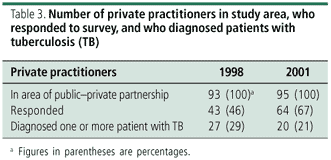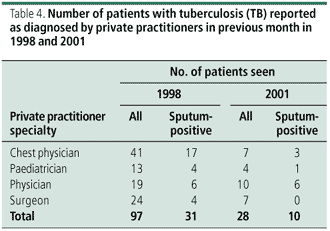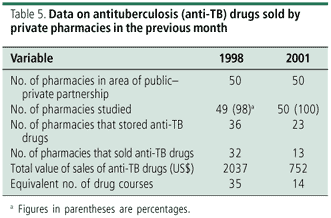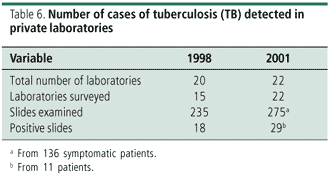RESEARCH
Control of tuberculosis in an urban setting in Nepal: publicprivate partnership
Lutte antituberculeuse en milieu urbain au Népal : partenariat entre les secteurs public et privé
Control de la tuberculosis en un entorno urbano del Nepal: alianza publicoprivada
James N. NewellI, 1; Shanta B. PandeI; Sushil C. BaralI; Dirgh S. BamII;Pushpa MallaII
INuffield Institute for Health, University of Leeds, Leeds LS2 9PL, England
IINational Tuberculosis Centre, Thimi, Nepal
ABSTRACT
OBJECTIVES: To implement and evaluate a publicprivate partnership to deliver the internationally recommended strategy DOTS for the control of tuberculosis (TB) in Lalitpur municipality, Nepal, where it is estimated that 50% of patients with TB are managed in the private sector.
METHODS: A local working group developed a publicprivate partnership for control of TB, which included diagnosis by private practitioners, direct observation of treatment and tracing of patients who missed appointments by nongovernmental organizations, and provision of training and drugs by the Nepal National TB Programme (NTP). The publicprivate partnership was evaluated through baseline and follow-up surveys of private practitioners, private pharmacies, and private laboratories, together with records kept by the Nepal NTP.
FINDINGS: In the first 36 months, 1328 patients with TB were registered in the publicprivate partnership. Treatment success rates were >90%, and <1% of patients defaulted. Case notification of sputum-positive patients in the study area increased from 54 per 100 000 to 102 per 100 000. The numbers of patients with TB started on treatment by private practitioners decreased by more than two-thirds, the number of private pharmacies that stocked anti-TB drugs by one-third, the number of pharmacies selling anti-TB drugs by almost two-thirds, and sales of anti-TB drugs in pharmacies by almost two-thirds. Private practitioners were happy to refer patients to the publicprivate partnership. Not all private practitioners had to be involved: many patients bypassed private practitioners and went directly to free DOTS centres.
CONCLUSIONS: A combination of the strengths of private practitioners, nongovernmental organizations, and the public sector in a publicprivate partnership can be used to provide a service that is liked by patients and gives high rates of treatment success and increased rates of patient notification. Similar publicprivate partnerships are likely to be replicable elsewhere, as inputs are not large and no special requirements exist.
Keywords: Tuberculosis, Pulmonary/diagnosis/prevention and control/drug therapy; Antitubercular agents/administration and dosage; Treatment outcome; Private sector; Public sector; Nongovernmental organizations; Community health centers; Intersectoral cooperation; Urban population; Program evaluation; Nepal (source: MeSH, NLM).
RÉSUMÉ
OBJECTIF: Instaurer et évaluer un partenariat entre les secteurs public et privé pour appliquer la stratégie de lutte antituberculeuse recommandée au niveau international (nommée DOTS) dans la municipalité de Lalitpur (Népal), où l'on estime que 50 % des patients tuberculeux sont pris en charge dans le secteur privé.
MÉTHODES: Un groupe de travail local a mis sur pied un partenariat entre les secteurs public et privé pour la lutte antituberculeuse : les praticiens privés posent le diagnostic, des organisations non gouvernementales se chargent d'assurer le traitement sous surveillance directe et de rechercher les patients qui ne se sont pas présentés à leur rendez-vous, tandis que le Programme national népalais de lutte contre la tuberculose assure la formation et fournit les médicaments. Pour évaluer cette forme de partenariat, des enquêtes de référence et de contrôle ont été menées auprès des praticiens libéraux ainsi que des pharmacies et des laboratoires privés, et les dossiers du programme national ont été étudiés.
RÉSULTATS: Au cours des 36 premiers mois, ce partenariat a enregistré 1 328 patients. Le taux de succès a été de plus de 90 % et le taux d'abandon de moins de 1 %. La notification des cas de tuberculose à frottis positif dans la zone étudiée est passée de 54/100 000 à 102/100 000. Le nombre des patients tuberculeux commençant leur traitement chez un praticien privé a diminué de plus des deux tiers, le nombre de pharmacies privées ayant en réserve des antituberculeux a baissé d'un tiers, le nombre des pharmacies vendant ces médicaments de près des deux tiers et la vente d'antituberculeux en pharmacie de près des deux tiers également. Les praticiens privés étaient heureux de pouvoir adresser leurs patients au partenariat. Tous n'y ont pas forcément participé : de nombreux patients se sont en effet rendus directement dans les centres de traitement DOTS gratuits.
CONCLUSION: En associant les atouts des praticiens privés, des organisations non gouvernementales et du secteur public dans cette forme de partenariat, on peut assurer un service apprécié des patients et obtenir des taux de réussite thérapeutique élevés et une augmentation du nombre des notifications. Il est probable que ce type de partenariat pourra être reproduit ailleurs, car il demande peu de ressources et ne nécessite l'existence d'aucune condition particulière préalable.
Mots clés: Tuberculose pulmonaire/diagnostic/prévention et contrôle/chimiothérapie; Antituberculeux/administration et posologie; Evaluation résultats traitement; Secteur privé; Secteur public; Organisations non gouvernementales; Centre public santé; Coopération intersectorielle; Population urbaine; Evaluation programme; Népal (source: MeSH, INSERM).
RESUMEN
OBJETIVO: Implantar y evaluar una alianza publicoprivada para aplicar la estrategia internacionalmente recomendada (bautizada como DOTS) de control de la tuberculosis (TB) en el municipio de Lalitpur, Nepal, donde se calcula que el 50% de los pacientes tuberculosos son tratados en el sector privado.
MÉTODOS: Un grupo de trabajo local formó una alianza publicoprivada para el control de la TB que incluía el diagnóstico por médicos privados, la observación directa del tratamiento y el rastreo de los pacientes que faltaron a las citas por las organizaciones no gubernamentales, y el suministro de formación y medicamentos por el Programa Nacional de Tuberculosis del Nepal. La alianza publicoprivada fue evaluada a partir de encuestas de referencia y de seguimiento de los médicos privados, las farmacias privadas y los laboratorios privados, así como de registros mantenidos por el Programa Nacional de Tuberculosis del Nepal.
RESULTADOS: En los 36 primeros meses se registró en la alianza publicoprivada a 1328 pacientes con TB. Las tasas de curación fueron superiores al 90%, y menos del 1% de los pacientes dejaron de seguir el tratamiento. La notificación de casos de pacientes con esputo positivo en el área estudiada aumentó de 54/100 000 a 102/100 000. El número de pacientes con TB que empezaron siendo tratados por médicos privados se redujo en más de dos terceras partes, el número de farmacias privadas con reservas de medicamentos antituberculosos lo hizo en una tercera parte, el número de farmacias expendedoras de medicamentos antituberculosos se redujo casi a la tercera parte, y las ventas de dichos medicamentos en farmacias disminuyeron también casi hasta la tercera parte. Los médicos privados mostraron muy buena disposición a derivar a los pacientes hacia la alianza publicoprivada. No todos los médicos privados tenían que participar: muchos pacientes los sorteaban y acudían directamente a los centros que administraban DOTS de forma gratuita.
CONCLUSIÓN: Combinando los puntos fuertes de los médicos privados, las organizaciones no gubernamentales y el sector público en forma de alianzas publicoprivadas, es posible prestar un servicio del agrado de los pacientes que garantice tasas altas de curación y mayores tasas de notificación de los casos. Se podrían formar alianzas publicoprivadas similares en otros lugares, pues ello no requiere grandes inversiones ni requisitos especiales.
Palabras clave: Tuberculosis pulmonar/diagnóstico/prevención y control/quimioterapia; Agentes antituberculosos/administración y dosificación; Resultado del tratamiento; Sector privado; Sector público; Organizaciones no gubernamentales; Centros comunitarios de salud; Cooperación intersectorial; Población urbana; Evaluación de programas; Nepal (fuente: DeCS, BIREME).

Introduction
Tuberculosis (TB) is the most common cause of death in adults, with South Asia being the worst affected region (1, 2).To avoid poor or incomplete treatment, which can lead to relapse, increased transmission, and drug-resistant TB, WHO and the International Union Against Tuberculosis and Lung Disease advocate use of the DOTS strategy (3, 4).A key component of this strategy is direct observation of treatment (DOT): that is, the patient should be "directly observed" as he or she swallows each dose of anti-TB treatment for at least the first two months of treatment by a person responsible to the health services. The DOTS strategy has been implemented successfully in the public sector by many National TB Programmes (NTPs). InSouth Asia, however, a large number of patients seek treatment for TB from private practitioners(1), particularly in urban centres (5), and the quality of this TB care generally has been shown to be very poor across all five components of DOTS (68). Currently, considerable international interest exists in the involvement of private practitioners in the control of TB (911), with India, Pakistan, and other countries developing policies for publicprivate partnerships. Pioneering workhas centred on Mahavir Trust Hospital in Hyderabad (12), but this is somewhat context specific, depending as it does on a charitable hospital and a highly experienced chest doctor who has close links with private practitioners.
In Nepal, over 10 000 new cases of smear-positive TB are notified each year (13).In urban areas, 50% of patients with TB are estimated to be managed in the private sector (14) (almost all licenced private practitioners are concentrated in the urban centres); these patients are unregistered. The quality of care for TB patients provided by private practitioners generally is very poor (15),leading to delayed cure, increased numbers of chronic transmitters, and drug resistance, and hence to an increasing incidence of TB. Most patients who use private practitioners are very poor. After the Nepal NTP developed a well-functioning strategy for TB control in the public sector, the programme felt it appropriate to focus on the private sector.
The Nepal NTP and the research team decided to develop a tailor-made publicprivate partnership for the control of TB in urban Nepal, the principles of which could be applied in other urban settings in the country. Lalitpur municipality, a medium-sized city in the Kathmandu valley with a population of about 200 000, was chosen by the NTP as an appropriate site for this initiative. The project aimed to develop, implement, and evaluate the publicprivate partnership. The specific research objectives were to assess the feasibility of developing and implementing a publicprivate partnership and to assess its success using the following criteria: in the study area, the overall cure rate among newly-registered, smear-positive patients with TB consistently attains the international target of 85%; the overall rate of non-completion of treatment is consistently <5%; the overall case notification rate increases after implementation of the publicprivate partnership; and the overall number of patients with TB treated in the study area with procedures not consistent with the DOTS strategy falls after implementation of the publicprivate partnership.
Methods
The main providers in the area were considered to be the public sector, a semi-public hospital (largely financed by an international nongovernmental organization but with joint decision-making by the nongovernmental organization and the government), and private providers (i.e., those not working in the public sector) consisting of not-for-profit nongovernmental organizations and for-profit private medical practitioners. Virtually all treatment for TB was thought to be performed by private-for profit qualified medical practitioners an assumption subsequently confirmed by a survey of non-allopathic private practitioners and unqualified allopathic medical practitioners in the study area (unpublished data). The survey confirmed that non-allopathic providers in the study area recognized the symptoms of TB and, rather than trying to treat the symptoms, recommended that patients seek treatment from allopathic doctors. We thus use the term private practitioner to refer to private for-profit qualified (MBBS or equivalent) medical practitioners.
The study group and the Nepal NTP formed a working group committee that consisted of representatives from the main provider stakeholders in the study area to develop a strategy that would be acceptable to all stakeholder groups. The committee comprised the director of the NTP, the district health officer, prominent private practitioners, representatives of Lalitpur Municipality, representatives from nongovernmental organizations likely to provide DOTS centres, and members of the research team. The working group committee took overall responsibility for the publicprivate partnership. Box 1 shows the strategy agreed by the committee.

Lalitpur Municipality's district health officer, who was responsible overall for the TB control programme in the study area, took responsibility for the day-to-day management of the publicprivate partnership. This included providing training for laboratory staff and DOT supervisors, supervising workers involved in control of TB, ensuring drug supply and distribution, and ensuring that DOTS centres followed standard NTP recording and reporting procedures. The district health officer's responsibilities thus corresponded to those of district health officers elsewhere i.e., overseeing and monitoring the components of the DOTS programme in their districts. Agreement was reached that microscopy services for the publicprivate partnership would be provided by one laboratory at a private nursing home, two laboratories run by nongovernmental organizations, and one laboratory at a semi-public referral hospital; DOT by the semi-public referral hospital, three nongovernmental organizations, and the private nursing home; and late patient tracing (tracing of patients who miss appointments) by municipality volunteers coordinated by a nongovernmental organization. DOTS centres had a memorandum of understanding with the district health office; other agreements were informal.
Initially, evening workshops were held to disseminate the NTP's concerns about treatment practices then current among private practitioners, internationally recommended guidelines for case management of TB, and services available to private practitioners under the publicprivate partnership. The evening workshops were largely unsuccessful in their initial aim of getting all private practitioners directly involved in improved case management: they proved to be not only unpopular with only 33 private practitioners attending from 93 identified in the study area but also expensive (and hence not replicable). As a result, we stopped arranging workshops and started visiting private practitioners in their clinics. We explained the publicprivate partnership project and distributed a specially developed clinical manual and map that showed the locations of treatment centres and guidelines for referral to them. The strategy agreed by the publicprivate partnership was to encourage private practitioners to use referral facilities for TB laboratory tests, DOT and complicated cases, rather than to provide all of the components of DOTS themselves. Every 68 months, all private practitioners were reminded about the publicprivate partnership, either by personal visits to their clinics or through educational materials that were sent to them.
Our original intention was to encourage as many private practitioners as possible to become actively involved in the publicprivate partnership. As time progressed, however, it became clear that many private practitioners were not interested in becoming providers of DOTS. The working group therefore changed the publicprivate partnership strategy from encouraging private practitioners to provide DOTS themselves to encouraging them to use referral facilities for TB laboratory tests, DOT and complicated cases.
The semi-public hospital, three nongovernmental organizations, and one private nursing home that operated in the area were prepared to become treatment centres to provide DOT. One nongovernmental organization with considerable experience in urban health care and with excellent outreach workers in the community agreed to coordinate municipality volunteers to provide late patient tracing in addition to providing DOT. A committed chest physician who worked at the private nursing home acted as consultant for referral of complicated cases.
No financial incentives were paid to private practitioners, laboratories, or providers of DOT, and no other incentives were provided, other than signs that confirmed that participating DOTS centres were accredited by the NTP. DOTS centres paid their own staff's salaries. Patients paid the standard consultation fee when they visited private practitioners. As is normal in Nepal, the NTP covered costs of training, drugs for DOTS centres (but not for individual private practitioners), laboratory supplies, and materials for recording and reporting. The costs of workshops and evaluation surveys for private practitioners were met by the research team.
Further details of the organizational set-up of the publicprivate partnership have been published elsewhere (16).
We considered it essential to evaluate the publicprivate partnership as rigorously as possible. As in other settings, we suspected it would prove impossible to obtain reliable relevant statistics on private practitioners' caseloads directly, as private practitioners did not and would not keep records. We therefore identified other indicators that were feasible to measure and which we considered sufficient to evaluate the project with comparisons before and after implementation:
the total number of patients with TB registered in the publicprivate partnership
private practitioners' recall of the number of patients with TB that they diagnosed and started on treatment
sales of anti-TB drugs in private pharmacies
the number of sputum examinations performed in private laboratories.
Three baseline surveys were carried out in the study area in 1998 before the publicprivate partnership was implemented. A door-to-door survey was used in the study area to identify all private practitioners (16), each of whom received a self-administered questionnaire to determine the caseload of TB patients, the TB treatment practices in the private sector, and the professional characteristics of private practitioners involved in the care of TB patients. A similar survey of all private pharmacies was conducted to determine sales of anti-TB drugs in private pharmacies (17).Finally, a door-to-door survey of all private laboratories was carried out to determine the numbers of acid-fast bacilli examinations and sputum-positive cases detected in private laboratories (18).In 2001, three years after initial implementation of the publicprivate partnership, the surveys were repeated.
Other information was obtained from the NTP's records. All five DOTS centres used standard NTP treatment cards and TB registers, and the four centres with laboratories used standard NTP laboratory registers. Following normal NTP practice, these records were cross-checked every four months by the district health officer, the regional NTP team, and peer groups at routine four-monthly regional TB workshops. An independent international review team visited these sites regularly to validate NTP records as part of the NTP review. Records were also checked periodically by the research team. Information on referrals from private practitioners to DOTS centres was recorded in the remarks column of the NTP's TB registers that were held at the DOTS centres. A referral was defined as any patient who attended a DOTS centre with a note from a private practitioner requesting the patient be started on treatment for TB. Referral information was subsequently verified by a research field worker. Census data were used as the denominator for calculations of case detection the catchment area was unchanged over the period reported here. Although patients who lived outside the catchment area could be diagnosed by the publicprivate partnership, they were referred to their area of residence for DOT, and hence would not appear in the publicprivate partnership's records.
Information on patient satisfaction was collected informally by members of the research team in discussions with patients who visited DOTS centres for monitoring purposes.
Results
In the first 36 months after implementation, 1328 patients with TB were registered in the publicprivate partnership: 210 (15.8%) of these were referrals from private practitioners, the remainder being self-referrals to DOTS centres (see Fig. 1).

The establishment of the publicprivate partnership increased case notification of sputum-positive patients in the study area from a pre-implementation level of 54 per 100 000 to 102 per 100 000 post-implementation, a rate that has remained steady over the three years of the publicprivate partnership (Table 1). Over the first three years, treatment success rates were >90%, and <1% of patients defaulted (Table 2), more than exceeding international targets.
In 1998, none of the patients diagnosed in the study area were on DOTS: in contrast, by 2001, 16 out of 28 patients diagnosed with TB by private practitioners in the previous month (data self-reported by private practitioners) had been referred to the DOTS centres (referral rate >50%). The surveys indicated that the number of patients with TB who were started on treatment by private practitioners had fallen by two-thirds (data self-reported by private practitioners) (Table 3 and Table 4). The surveys of private pharmacies showed a one-third fall in the number of pharmacies that stocked anti-TB drugs, a decrease of almost two-thirds in the number that sold such drugs, and a decrease of almost two-thirds in the number of sales of anti-TB drugs in these pharmacies (data self-reported by pharmacies) (Table 5). Results for the follow-up survey of private laboratories showed consistency between the number of patients diagnosed as smear positive (n = 11), the number of smear-positive patients with TB who were started on treatment by private practitioners (n = 10), and the quantities of drugs sold by private pharmacies (the equivalent of 14 courses of drugs) (Table 6). Despite repeated attempts, in the first survey, we were unable to get information from five small laboratories that were staffed very irregularly. The numbers of sputum-smear microscopy tests performed at these laboratories, however, were thought to be negligible.




In the study area, most patients with TB do not have to travel more than 15 minutes to reach the nearest DOTS centre, and informal discussions have shown that they are pleased with the arrangements. Similarly, private practitioners confirm that, now they have developed confidence in the quality and sustainability of the publicprivate partnership, they are happy to refer patients to participating DOTS centres. Additionally, and unexpectedly, many patients with TB bypass private practitioners and go directly to the free DOTS centres.
Discussion
This study showed the feasibility of implementing a publicprivate partnership for control of TB, which achieved a treatment success rate of >90% and simultaneously increased the case notification rate. Public services are often perceived as technically good but with a tendency to treat diseases rather than people and at inconvenient locations and times. In contrast, private practitioners generally provide convenience and a holistic approach, but their TB patient retention and cure rates generally are very poor. Nongovernmental organizations often show strengths in community involvement and advocacy. By combining the strengths of private practitioners, nongovernmental organizations, and the public sector, publicprivate partnerships can provide services that give very high treatment success rates and increased case notification rates. (Although Hurtig et al. reported no change in TB case detection in the first eight months of the project (16),the apparent contradiction arose because they included all patients with TB registered in Patan hospital, many of whom came from outside the catchment area.)
Unfortunately, direct evaluation of the numbers of patients seen by private practitioners was not possible. Private practitioners' recall of the number of patients with TB that they saw may have been unreliable, but a close match was seen between the number of sputum-positive patients with TB that the private practitioners said they diagnosed and put on treatment and the numbers that were reported by the private laboratories over the same period. Recall bias also could have occurred in the pharmacy questionnaire survey, although the pharmacists seemed well aware of the medicines in stock and their turnover. Potential problems also exist when the numbers of patients who buy anti-TB drugs from private pharmacies are estimated from sales of such drugs in pharmacies, because patients may not complete treatment and patients from outside the project area may buy medicines from pharmacies inside the area. With respect to the survey of laboratories, the introduction of the publicprivate partnership could have caused a shift in the preferred diagnostic technique from chest X-rays to sputum testing, so that this measure of change in use of private practitioners is potentially biased. The main purpose of the surveys of laboratories, however, was to compare the results with the findings of the surveys of private practitioners. Although the robustness of each of the surveys individually may be open to question, all have comparable implications, and triangulation of findings from the three techniques strongly suggests a sharp decline in diagnosis and treatment by private practitioners outside the framework of the publicprivate partnership.
A key finding was that it was not necessary to involve all private practitioners in the publicprivate partnership. Many patients went for diagnosis directly to a DOTS centre, having learned about the services available from sources other than private practitioners. When all private practitioners do not need to be involved, the complications and costs of implementing and sustaining a publicprivate partnership are considerably reduced. Further work is in progress to determine the costs of developing and maintaining the publicprivate partnership and hence its cost-effectiveness.
The publicprivate partnership is not a static entity but continues to evolve to meet the changing strengths, weaknesses, and commitment of private practitioners, nongovernmental organizations, and the NTP. For example, in the long-term, support from nongovernmental organizations for advocacy and late patient tracing could cease, and efforts are therefore being made to ensure the local municipality can sustain the ongoing activities. Lalitpur Municipality has formal responsibility for the health of the residents and it is expected that when it has adequate human and other resources to meet this responsibility, it will take responsibility for TB control activities, including management of the publicprivate partnership. Also, we hope to encourage other nongovernmental organizations or private clinics to become DOTS centres which should further improve patient access and enable the publicprivate partnership to continue should some partners withdraw. We are currently working to replicate the publicprivate partnership in other urban centres in Nepal and hope that similar efforts will be possible elsewhere in Asia. Replication should not be difficult, as the inputs required are limited: the process is flexible with no special requirements and builds on local strengths.
Conclusion
Publicprivate partnerships for control of TB can give high cure rates while increasing coverage. This is a pragmatic solution to the specific problem of private practitioners' involvement in treatment of TB and its impact on control of the disease in areas where to ignore the status quo is likely to lead to increased incidence and drug-resistant strains (9). This is not to say, however, that publicprivate partnerships are appropriate for all diseases further testing would be needed before such a conclusion could be drawn.
We end with a word of warning. We believe that a publicprivate partnership for control of TB should be considered only when a country's national TB programme is strong. The public sector must take long-term overall responsibility for public health and needs to show commitment to ensuring that standards of care are maintained and to react quickly when problems arise. If the public sector is weak, a publicprivate partnership may encourage the private sector to expand provision of TB services that have low patient retention and cure rates, thus threatening public health and potentially weakening the public sector still further. The effects of a poor publicprivate partnership may prove to be irreversible: for example, developing countries do not have the resources to tackle the widespread multidrug-resistant TB that could develop as a result of poor control of standards of care. 
Acknowledgements
We thank the patients and staff of the health centres involved in this study, Yala Urban Health Project, Nepal's NTP for permission to carry out the study, Klaus Jochem for initial work, Ian Smith for advice and support, and Andrew Green and two anonymous referees for helpful comments on the article.
Funding: This study was funded by the Department for International Development (DFID) of the United Kingdom; however, DFID can accept no responsibility for any information provided or views expressed.
Conflicts of interest: none declared.
References
1. World Health Organization. Global tuberculosis control: WHO report 2000. Geneva: World Health Organization; 2000. WHO document WHO/CDS/TB/2000.275
2. Dye C, Scheele S, Dolin P, Pathania V, Raviglione NC. Global burden of tuberculosis: estimated incidence, prevalence and mortality by country. Journal of the American Medical Association 1999;282:677-86.
3. Maher D, Chaulet P, Spinaci S, Harries A. Treatment of tuberculosis: guidelines for national programmes. Geneva: World Health Organization; 1997. WHO document WHO/TB/97.220
4. Enarson DA, Rieder HL, Arnadottir T, Trebucq A. Management of tuberculosis: a guide for low income countries. Paris: International Union Against Tuberculosis and Lung Disease; 2000.
5. Uplekar M, Pathania V, Raviglione M. Private practitioners and public health: weak links in tuberculosis control. Lancet 2001;385:912-6.
6. Uplekar MW, Rangan S. Private doctors and tuberculosis control in India. Tubercle and Lung Disease 1993;74:332-7.
7. Uplekar M, Juvekar S, Morankar S, Rangan S, Nunn P. Tuberculosis patients and practitioners in private clinics in India. International Journal of Tuberculosis and Lung Disease 1998;2:324-9.
8. Khan A, Walley J, Newell J, Imdad N. Tuberculosis in Pakistan: socio-cultural constraints and opportunities in treatment. Social Science and Medicine 2000;50:247-54.
9. Newell JN. The implications for TB control of the growth in numbers of private practitioners in developing countries. Bulletin of the World Health Organization 2002;80:836-7.
10. Uplekar M. Involving private medical sector in tuberculosis control: practical aspects. In: Porter JDH, Grange JG, editors. Tuberculosis: an international perspective. London: Imperial College Press; 1999.
11. Uplekar M, Pathania V, Raviglione M. Involving private practitioners in tuberculosis control: issues, interventions and emerging policy framework. Geneva: World Health Organization; 2001.
12. Murthy KJR, Frieden TR, Yazdani A, Hreshikesh P. Public-private partnership in tuberculosis control: experience in Hyderabad, India. International Journal of Tuberculosis and Lung Disease 2001;5:3549.
13. Nepal NTP. Tuberculosis control in Nepal: status report, May 1997. Nepal: National Tuberculosis Centre; 1997.
14. His Majesty's Government of Nepal, Ministry of Health and the World Health Organization. TB control in Nepal 1995-1999: a development plan for the National TB Programme. Nepal: National Tuberculosis Centre; 1995.
15. Hurtig AK, Pande SB, Porter JDH, Bam DS. Tuberculosis treatment and private practitioners, Kathmandu Valley. Journal of the Nepal Medical Association 2000:39:163-8.
16. Hurtig AK, Pande SB, Baral SC, Newell J, Porter JD, Bam DS. Linking private and public sectors in tuberculosis treatment in Kathmandu Valley, Nepal. Health Policy and Planning 2002;17:78-89.
17. Hurtig AK, Pande SB, Baral SC, Porter JDH, Bam DS. Sputum examination for acid-fast bacilli in private laboratories, Kathmandu Valley, Nepal. International Journal of Tuberculosis and Lung Disease 1999;3:1009-14.
18. Hurtig AK, Pande SB, Baral SC, Porter JDH, Bam DS. Anti-tuberculosis treatment in the private pharmacies, Kathmandu Valley, Nepal. International Journal of Tuberculosis and Lung Disease 2000;4:730-6.
Submitted: 8 November 02 Final revised version received: 18 July 03 Accepted:22 July 03
1 Correspondence should be sent to Dr Newell at this address (j.n.newell@leeds.ac.uk).
